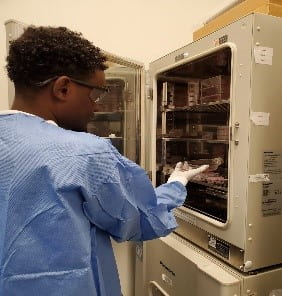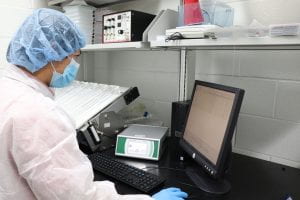Beckman Coulter Avanti J-E Centrifuge: Avanti J-E is a temperature-controlled ultracentrifuge used for separation tasks in our lab. With a maximum speed of 21,000 RPM (49392 xg) and volume maximum capacity of 4L, Avanti centrifuge is well equipped for separation protocols involving nanoparticles, protein, DNA, RNA , metal nano-colloids, and more. This ultracentrifuge is highly used for nanoparticle separation and DNA isolation in our lab.
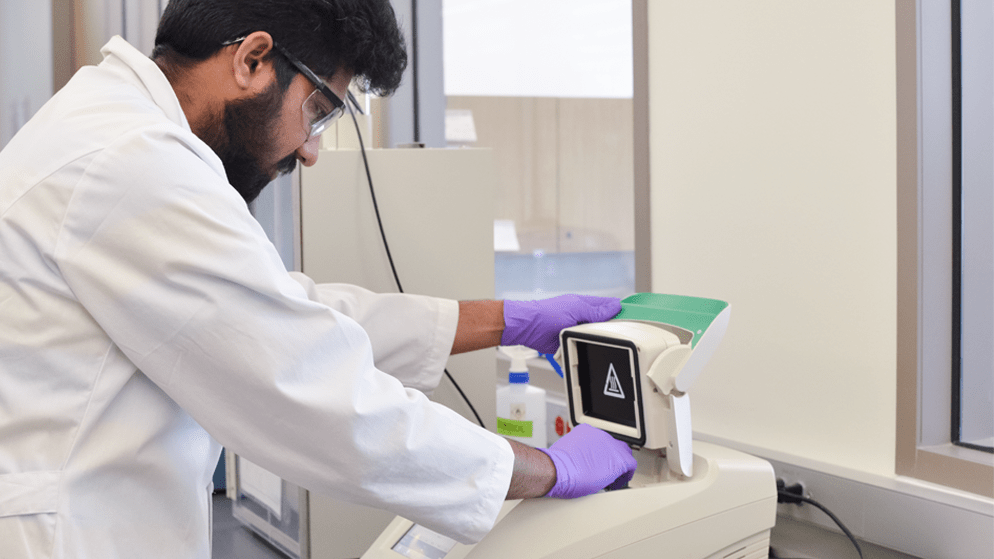 BioRad T100™ Thermal Cycler: The thermocycler is used for any temperature sensitive and controlled reactions including polymerase chain reaction and DNA digestion. T100 is a compact system with 96 well sample block that can work a temperature range of 40C to 1000C ± 0.50C. With the inbuilt gradient function, T-100 can provide more optimized results with minimal work. The 96-well sample block and self-adjusting heated lid accommodate standard tubes, tube strips, and plates.
BioRad T100™ Thermal Cycler: The thermocycler is used for any temperature sensitive and controlled reactions including polymerase chain reaction and DNA digestion. T100 is a compact system with 96 well sample block that can work a temperature range of 40C to 1000C ± 0.50C. With the inbuilt gradient function, T-100 can provide more optimized results with minimal work. The 96-well sample block and self-adjusting heated lid accommodate standard tubes, tube strips, and plates.
 CytoViva® Hyperspectral Microscopy: The hyperspectral microscope is used for spectral characterization and mapping of microscale and nanoscale materials. It maps each pixel of images to its spectral footprint. CytoViva has also been used for taking flourescent images from cellular uptake of nanoparticles, liposomes, and microparticles. Objectives 5X to 100X and the fluorescent module can capture fluorescent images with 700.000 pixels while the hyperspectral data were recorded with a resolution of 2nm enabling minute spectral differences to be measured from pixel to pixel within images.
CytoViva® Hyperspectral Microscopy: The hyperspectral microscope is used for spectral characterization and mapping of microscale and nanoscale materials. It maps each pixel of images to its spectral footprint. CytoViva has also been used for taking flourescent images from cellular uptake of nanoparticles, liposomes, and microparticles. Objectives 5X to 100X and the fluorescent module can capture fluorescent images with 700.000 pixels while the hyperspectral data were recorded with a resolution of 2nm enabling minute spectral differences to be measured from pixel to pixel within images.
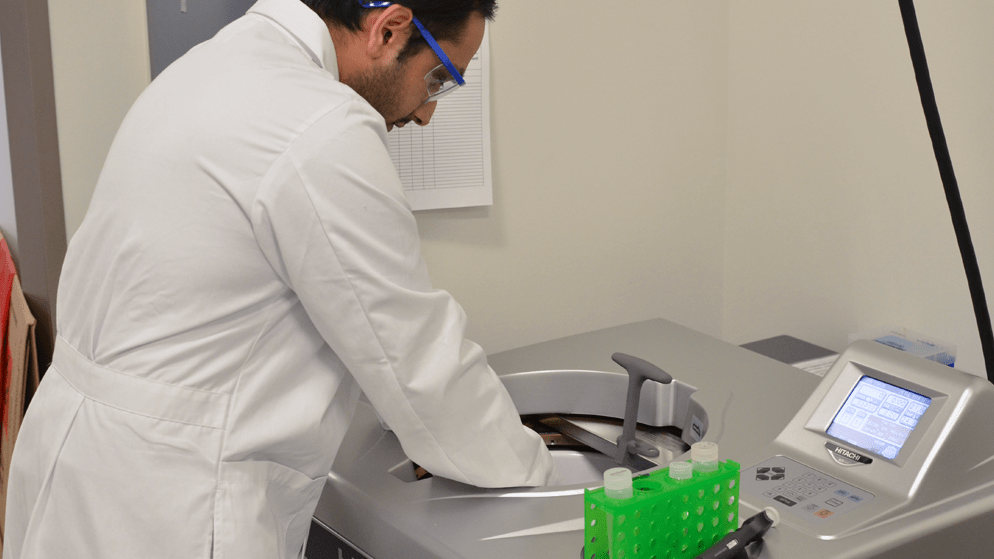 Hitachi himac CP100WX Ultracentrifuge: The CP100WX is a general-purpose ultra-refrigerated centrifuge used for separation tasks in the lab. It can run up to 100.000 RPM (803,000 xg), which makes it an excellent tool for applications involving biochemistry, cell biology, and nanomaterials. It can be used for a wide range of separation protocols involving proteins, DNA, RNA, metal nano-colloids, and more. The device is equipped with a non-contact imbalance detection sensor which can sense major vibrations to stop running cycles. The main purpose of this equipment’s design is the rapid separation of intermediate-to-large volume sample.
Hitachi himac CP100WX Ultracentrifuge: The CP100WX is a general-purpose ultra-refrigerated centrifuge used for separation tasks in the lab. It can run up to 100.000 RPM (803,000 xg), which makes it an excellent tool for applications involving biochemistry, cell biology, and nanomaterials. It can be used for a wide range of separation protocols involving proteins, DNA, RNA, metal nano-colloids, and more. The device is equipped with a non-contact imbalance detection sensor which can sense major vibrations to stop running cycles. The main purpose of this equipment’s design is the rapid separation of intermediate-to-large volume sample.
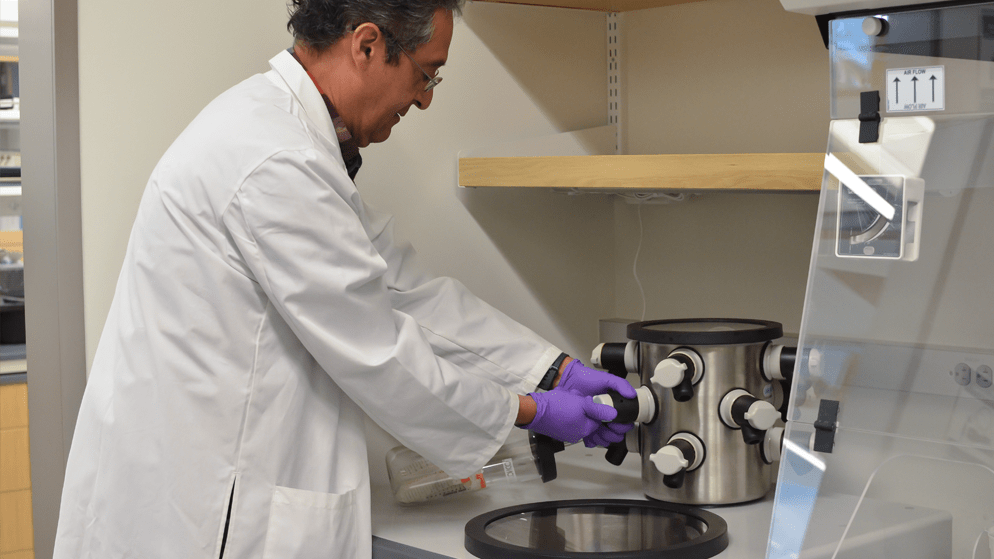 Labconco FreeZone 6 Freeze Dry System Model 77530: This equipment is designed to lyophilize samples by converting the frozen water directly into vapor without the intermediate formation of liquid water. The cabinet features a front viewing window console and a vacuum pump able displace up to 144 liters per minute and reach vacuum conditions as low as 0.002 mBar. The upright stainless steel collector coil holds 6 liters of ice before defrosting. A single 3/4 hp HCFC/CFC-free refrigeration system cools the collector to -50° C (-58° F), suitable for aqueous samples. This equipment are mainly used to lyophilize nanoparticles, proteins, and cell membrane in our lab.
Labconco FreeZone 6 Freeze Dry System Model 77530: This equipment is designed to lyophilize samples by converting the frozen water directly into vapor without the intermediate formation of liquid water. The cabinet features a front viewing window console and a vacuum pump able displace up to 144 liters per minute and reach vacuum conditions as low as 0.002 mBar. The upright stainless steel collector coil holds 6 liters of ice before defrosting. A single 3/4 hp HCFC/CFC-free refrigeration system cools the collector to -50° C (-58° F), suitable for aqueous samples. This equipment are mainly used to lyophilize nanoparticles, proteins, and cell membrane in our lab.
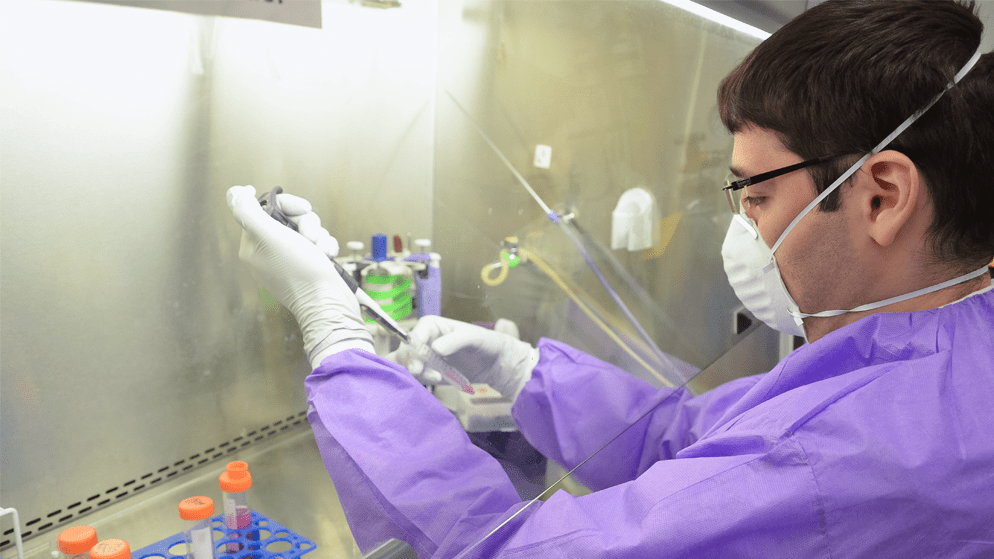 LabGard® ES NU-540 Class II, Type A2 Biosafety Cabinet : NU-540 is biosafety cabinet for working with all low to moderate biological hazard materials. The true laminar unidirectional airflow greatly reduces chances of cross contamination for cell experiments. It also has a dynamic air barrier that provides maximum personal protection from any airbone pathogens. With larger work area and attached vaccum system the NU-540 is an excellent and safe workspace for any biological work. We equipped two type 2 biosafety cabinets in our lab: one for cell experiments and the other for bacterial experiments.
LabGard® ES NU-540 Class II, Type A2 Biosafety Cabinet : NU-540 is biosafety cabinet for working with all low to moderate biological hazard materials. The true laminar unidirectional airflow greatly reduces chances of cross contamination for cell experiments. It also has a dynamic air barrier that provides maximum personal protection from any airbone pathogens. With larger work area and attached vaccum system the NU-540 is an excellent and safe workspace for any biological work. We equipped two type 2 biosafety cabinets in our lab: one for cell experiments and the other for bacterial experiments.
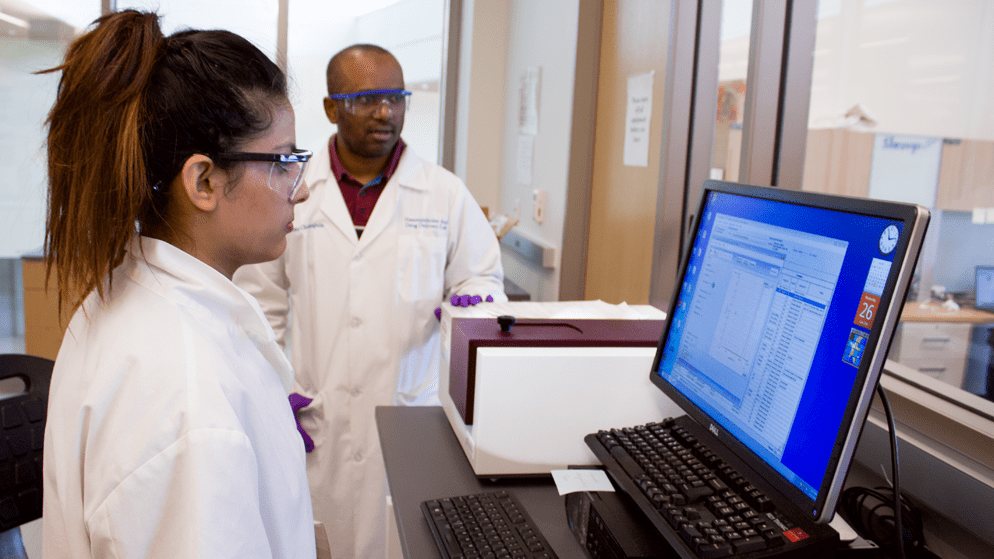 NanoBrook 90Plus PALS: Nanoparticle characterization including size and surface charge determination is vital in the design and development of various drug delivery systems. The NanoBrook device in our lab has a dual capability of sizing and measuring the surface charges of the nano/micro particles. Dynamic light scattering (DLS) technique is used by Nanobrook for analyzing sizes and polydispersity of the nano/micro particles. Phase analysis light scattering (PALS) technique will determine surface charges of particles.
NanoBrook 90Plus PALS: Nanoparticle characterization including size and surface charge determination is vital in the design and development of various drug delivery systems. The NanoBrook device in our lab has a dual capability of sizing and measuring the surface charges of the nano/micro particles. Dynamic light scattering (DLS) technique is used by Nanobrook for analyzing sizes and polydispersity of the nano/micro particles. Phase analysis light scattering (PALS) technique will determine surface charges of particles.
Panasonic MCO-18ACUV-PA – Carbon-dioxide Incubator: Carbon dioxide incubators offers a high-performance solution for cell cultures applications by providing sustainable in vitro model of in vivo environment for optimal cell growth and productivity. InCu-saFe copper enriched stainless-steel interior gives active background contamination control and SafeCell UV protection located below the interior base helps destroy any airborne contaminants during door openings. Overall, the CO2 incubator is used for conventional incubation of cell cultures and other incubation-related cell culture experiments in our lab.
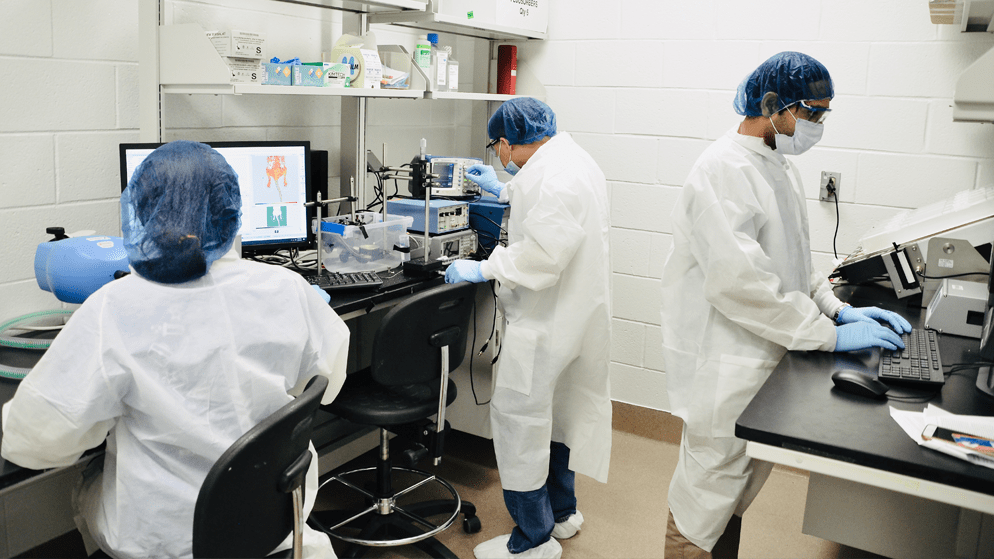
PeriCam PSI Normal Resolution: The PeriCam PSI System is the in vivo imaging system based on Laser Speckle Contrast Analysis (LASCA) technology that allows visualization of tissue blood perfusion in real-time and combines dynamic response with high spatial resolution to study the microcirculation. The high resolution (1388×1038 pixels) camera can capture up to 100 frames per second. The system will not only provide high resolution images of the blood perfusion distribution, but also open the possibility to follow the vascular dynamics for cardiovascular diseases.
Panlab Touchscreen Treadmill: The treadmills are rolling belts with an adjustable speed (0.4 to 150 cm/s) and slope (-25 to 25 degree), enabling forced exercise training and accurate testing of fatigue in rodents. The system has been used to measure physical abilities of peripheral arterial disease (PAD) mice.
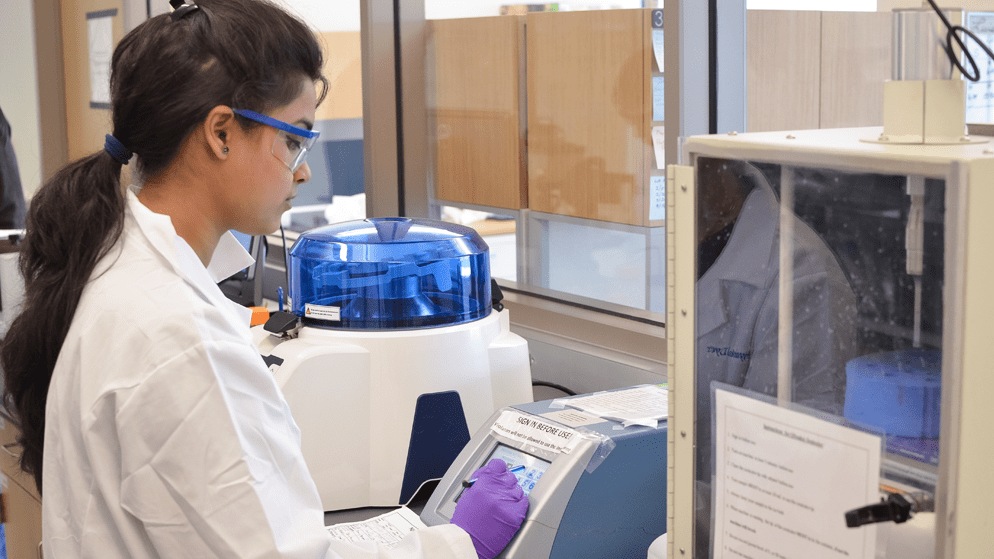 Q Sonica Sonicator Q700: Sonication involves application of sound energy to agitate particles and breakdown of particle agglomerates resulting in smaller uniform particles. Various sonication probes have used for various nanoparticle synthesis processes such as emulsification, dispersing, deagglomerating, particle size reduction, and so on. We also equipped another sonicator bath to process sensitive materials such as mammalian cell and bacterial cell lysis.
Q Sonica Sonicator Q700: Sonication involves application of sound energy to agitate particles and breakdown of particle agglomerates resulting in smaller uniform particles. Various sonication probes have used for various nanoparticle synthesis processes such as emulsification, dispersing, deagglomerating, particle size reduction, and so on. We also equipped another sonicator bath to process sensitive materials such as mammalian cell and bacterial cell lysis.
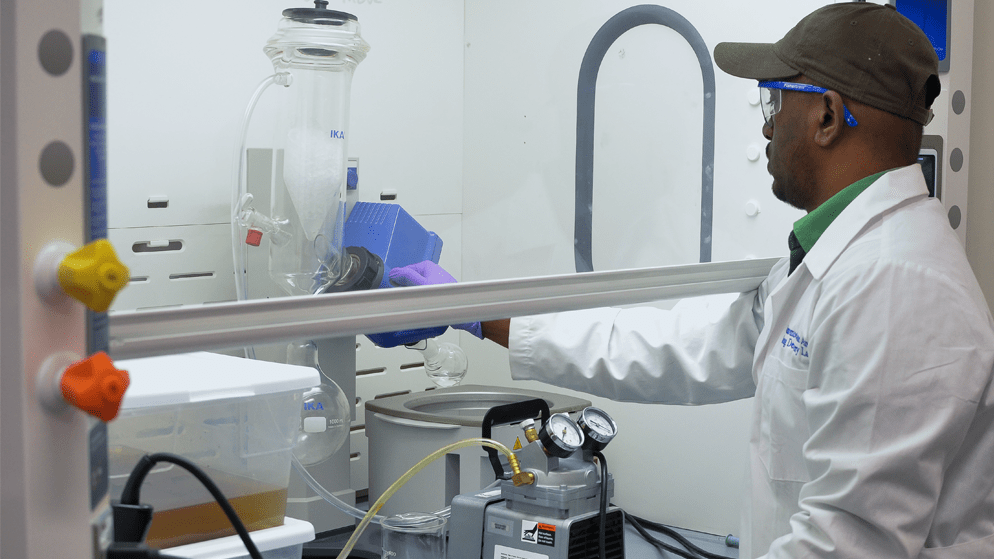 Rotary Evaporation– IKA RV-8: This equipment mainly aids in efficient and gentle removal of solvents from samples by evaporation. Centrifugal force in combination with the frictional force between the rotating flask wall and the liquid sample is used to evaporate solvents and form thin layer of lipids, etc., as part of thin-film hydration technique. The heating bath can adjust a wide temperature range that makes it ideal for versatile application. The IKA RV-8 model rotary evaporator with high pressure vacuum pump is majorly used in fabrication of liposomes and microbubbles used in design and development of various drug delivery systems.
Rotary Evaporation– IKA RV-8: This equipment mainly aids in efficient and gentle removal of solvents from samples by evaporation. Centrifugal force in combination with the frictional force between the rotating flask wall and the liquid sample is used to evaporate solvents and form thin layer of lipids, etc., as part of thin-film hydration technique. The heating bath can adjust a wide temperature range that makes it ideal for versatile application. The IKA RV-8 model rotary evaporator with high pressure vacuum pump is majorly used in fabrication of liposomes and microbubbles used in design and development of various drug delivery systems.
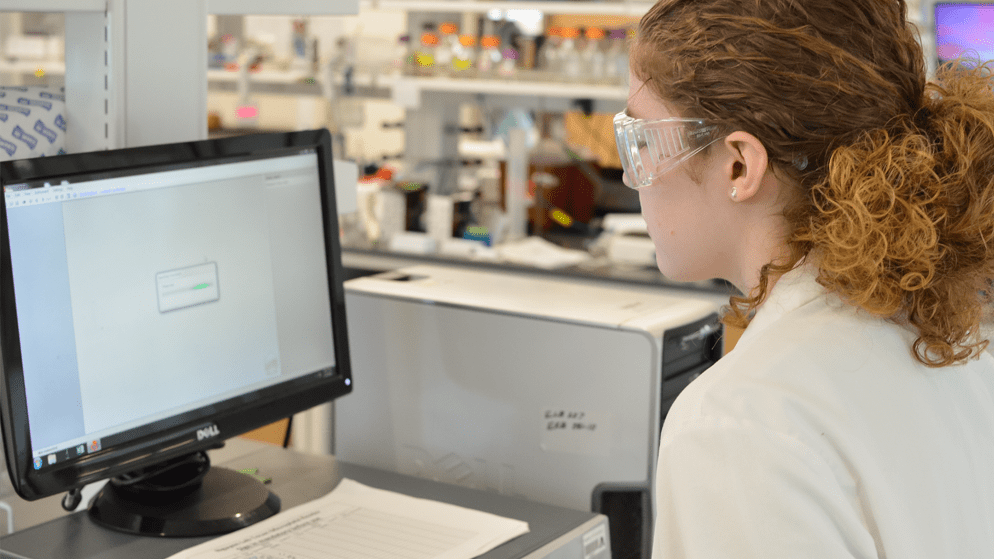 Tecan Infinite M200 Spectrophotometer: It’s premium Quad4 Monochromators provide exceptional sensitivity and allow the selection of any wavelengths from UV to NIR to measure fluorescent, absorbant and luminescent intensities. The reader offers several detection modes for sample measurements in 6- to 384- well plates such as top or bottom fluorescent intensities, fluorescent time resolved, flash flourescence, absorbance, absorbance with injectors, absorbance with cuvette, glow type chemi- or bioluminescence, bioluminescence resonance energy transfer, and flash luminescence. The Infinite M200 can be used for a wide range of biological assays and measurements including DNA/RNA quantification, protein quantification, MTS assays, binding studies, enzyme assays, immunoassays, fluorescent and luminescent applications.
Tecan Infinite M200 Spectrophotometer: It’s premium Quad4 Monochromators provide exceptional sensitivity and allow the selection of any wavelengths from UV to NIR to measure fluorescent, absorbant and luminescent intensities. The reader offers several detection modes for sample measurements in 6- to 384- well plates such as top or bottom fluorescent intensities, fluorescent time resolved, flash flourescence, absorbance, absorbance with injectors, absorbance with cuvette, glow type chemi- or bioluminescence, bioluminescence resonance energy transfer, and flash luminescence. The Infinite M200 can be used for a wide range of biological assays and measurements including DNA/RNA quantification, protein quantification, MTS assays, binding studies, enzyme assays, immunoassays, fluorescent and luminescent applications.
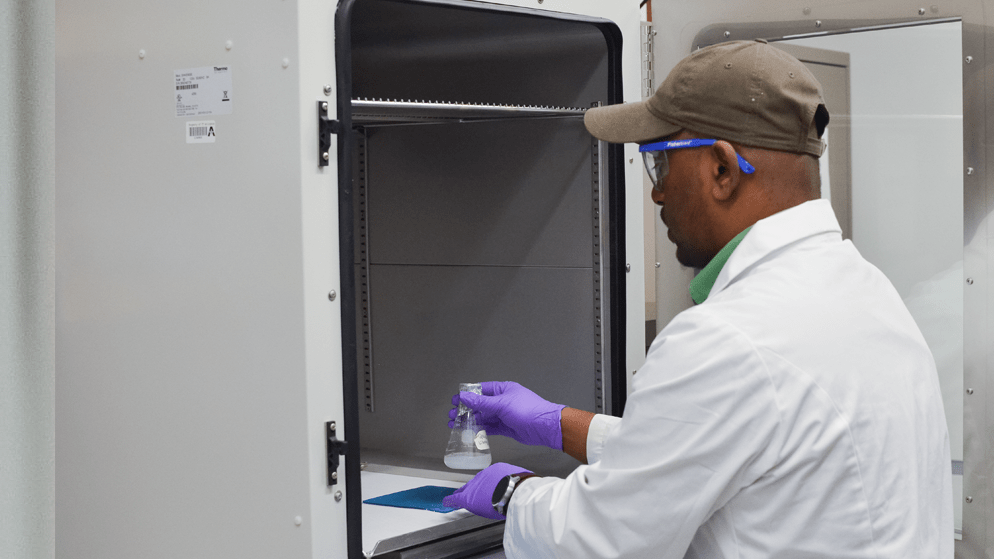 Thermo Scientific MaxQ6000 Shaker Incubator: Shaking incubators are widely used in bacterial and yeast cultures, solubility studies, extraction procedures including plasmids and bacterial proteins, general mixing, washing procedures and destaining. MaxQ6000 provides two stacked levels facilitating large workspace for orbital shaking and incubation.
Thermo Scientific MaxQ6000 Shaker Incubator: Shaking incubators are widely used in bacterial and yeast cultures, solubility studies, extraction procedures including plasmids and bacterial proteins, general mixing, washing procedures and destaining. MaxQ6000 provides two stacked levels facilitating large workspace for orbital shaking and incubation.
Dr. Nguyen also has several other equipment, including flow bioreactors, stretch systems, syringe pumps, benchtop centrifuges, vacuum ovens, refrigerators, freezers, balances, stir/hot plates, vortex mixers, and rocking shakers. In addition, anesthetic machines, surgical microscopes, equipment, and supplies are available at the animal facilities. Dr. Nguyen also has access to equipment specifically for inhalation drug delivery: gas chromatograph (Varian); one ventilator (Harvard Apparatus and Columbus Instruments) and nebulization system (AeronebÒ); and a non-invasive monitoring system (Kent Scientific) for oximetry, blood pressure and heart rate.

